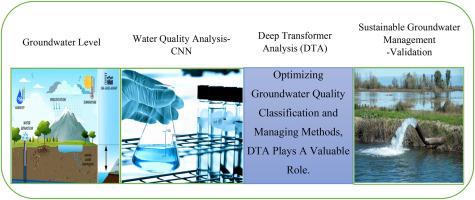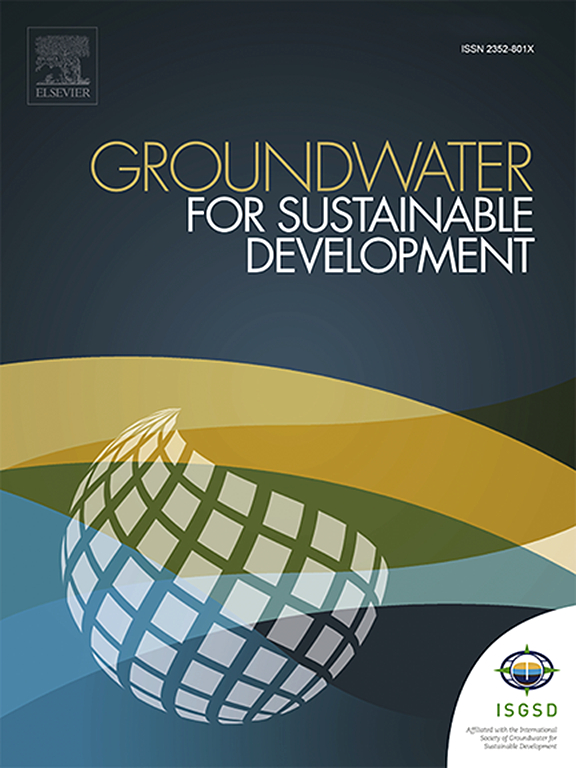通过深度学习改变地下水的可持续性、管理和开发
IF 4.9
Q2 ENGINEERING, ENVIRONMENTAL
引用次数: 0
摘要
尽管地下水在满足全球淡水需求方面发挥着至关重要的作用,但由于过度开采、污染和气候变化,地下水(GW)的可用性正面临风险。使用过时的、数据驱动不足的地下水管理模式做出的决策并不总是最佳选择。传统的方法往往无法解决地下水系统错综复杂、瞬息万变的问题,即使地下水管理已经取得了长足的进步。地下水的过度开采、污染和枯竭是监测、预测和管理不力的后果,危及环境的可持续性和水安全。通过利用人工智能(AI)的一种--深度学习(DL)的潜力,为预测模型和水质评估(WQA)提供了一种革命性的技术。然后,确定了现有地下水管理方法(GM)在预测地下水水位变化时所面临的局限性,还预测了水质(水质)恶化的快速检测。应用 DL 算法可进行精确预测和早期检测,本研究还旨在通过对过去和现在的数据执行 DL 算法来填补空白。通过解决这些传统方法的缺点,DL 中的模式识别(PR)和分析可以彻底改变这些程序。本研究采用了卷积神经网络(CNN)、递归神经网络(RNN),特别是长短期记忆(LSTM)网络来预测全球变暖水平模型。通过应用支持特定管理方法的深度变换器分析(DTA),揭示了大型数据集中的隐藏模式。研究结果表明了 DL 技术的革命性影响。LSTM 网络促进了对全球变暖变化和主动资源管理的精确预测。CNN 可准确确定 GQA,及早检测 PH 值和污染物水平等指标。DTA 有助于有效地对全球变暖质量等级进行分类,并优化管理技术。通过将这些先进技术应用于历史数据和实时数据,本研究提出了精确的全球水位变化预测模型和准确的 WQA 参数。前瞻性资源管理、早期检测能力和 GW 资源的可持续性促进了 DL 的变革潜力和所取得的成果。与其他现有技术相比,CNN-DTA 模型的准确率提高了 97.2%,F1 分数提高了 96.2%,MAE(平均绝对误差)降低了 0.8%,RMSE(均方根误差)降低了 1.1%,损失率降低了 0.04%。本文章由计算机程序翻译,如有差异,请以英文原文为准。

Transforming groundwater sustainability, management and development through deep learning
Groundwater (GW) availability is at risk due to over-extraction, pollution, and climate change, despite their vital role in satisfying the world's freshwater needs. Decisions made using outdated, under-data-driven models for groundwater management are not always the best option. Traditional approaches often fail to tackle groundwater systems' intricacies and ever-changing nature, even if groundwater management has come a long way. Groundwater over-extraction, pollution, and depletion are consequences of ineffective monitoring, prediction, and management, which endangers environmental sustainability and water security.
The rising problems of Sustainable Groundwater Management (SGM) and development in the context of global freshwater demand and climate change were addressed in this study. A revolutionary technique for predicting models and the Water Quality Assessment (WQA) by employing the potential of Deep Learning (DL), a type of Artificial Intelligence (AI). Then, the limitations faced by the existing Groundwater Management methods (GM) in predicting the Variations in the GW levels were identified, and it also predicted the quick detection of the WQ (Water Quality) deterioration. The application of DL algorithms offers precise prediction and early detection, and this study also aims to fill the gaps by executing DL on past and present data. By addressing the drawbacks of these traditional methods, Pattern Recognition (PR) and analysis in the DL can revolutionize these procedures. For predicting the modelling of GW levels, the Convolutional Neural Networks (CNN), Recurrent Neural Networks (RNN), and particularly Long Short Term Memory (LSTM) networks are employed in this study.
For WQA, Deep CNN (DCNN) are employed. The hidden patterns are revealed within the large datasets by applying Deep Transformer Analysis (DTA), which supports specific management approaches. The outcomes demonstrated the revolutionary impact of DL techniques. The LSTM networks facilitated the precise predictions for GW variations and Proactive Resource management. CNN accurately determined the GQA, detecting indicators like PH and level of pollutants early. The DTA contributed to classifying the GW quality levels effectively and optimizing the management techniques. The precise predictive models for GW level variations and accurate WQA parameters were presented in this study by applying these advanced techniques to historical and real-time data. The proactive resource management, early detection capabilities, and sustainability of GW resources facilitate the transformative potential of DL and the outcomes obtained. The enhanced accuracy rate of 97.2%, F1 score rate of 96.2%, MAE (Mean Absolute Error) rate of 0.8%, RMSE (Root Mean Square Error) of 1.1%, loss rate of 0.04% were attained by the suggested CNN-DTA model when compared to other current techniques.
求助全文
通过发布文献求助,成功后即可免费获取论文全文。
去求助
来源期刊

Groundwater for Sustainable Development
Social Sciences-Geography, Planning and Development
CiteScore
11.50
自引率
10.20%
发文量
152
期刊介绍:
Groundwater for Sustainable Development is directed to different stakeholders and professionals, including government and non-governmental organizations, international funding agencies, universities, public water institutions, public health and other public/private sector professionals, and other relevant institutions. It is aimed at professionals, academics and students in the fields of disciplines such as: groundwater and its connection to surface hydrology and environment, soil sciences, engineering, ecology, microbiology, atmospheric sciences, analytical chemistry, hydro-engineering, water technology, environmental ethics, economics, public health, policy, as well as social sciences, legal disciplines, or any other area connected with water issues. The objectives of this journal are to facilitate: • The improvement of effective and sustainable management of water resources across the globe. • The improvement of human access to groundwater resources in adequate quantity and good quality. • The meeting of the increasing demand for drinking and irrigation water needed for food security to contribute to a social and economically sound human development. • The creation of a global inter- and multidisciplinary platform and forum to improve our understanding of groundwater resources and to advocate their effective and sustainable management and protection against contamination. • Interdisciplinary information exchange and to stimulate scientific research in the fields of groundwater related sciences and social and health sciences required to achieve the United Nations Millennium Development Goals for sustainable development.
 求助内容:
求助内容: 应助结果提醒方式:
应助结果提醒方式:


